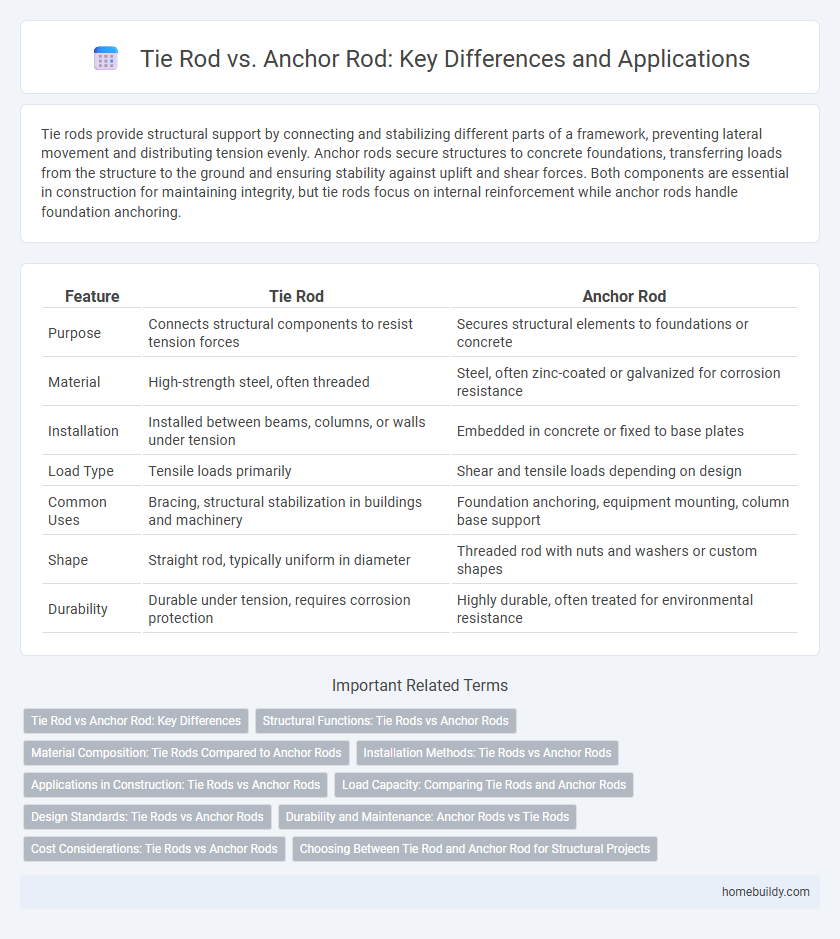Tie rods provide structural support by connecting and stabilizing different parts of a framework, preventing lateral movement and distributing tension evenly. Anchor rods secure structures to concrete foundations, transferring loads from the structure to the ground and ensuring stability against uplift and shear forces. Both components are essential in construction for maintaining integrity, but tie rods focus on internal reinforcement while anchor rods handle foundation anchoring.
Table of Comparison
| Feature | Tie Rod | Anchor Rod |
|---|---|---|
| Purpose | Connects structural components to resist tension forces | Secures structural elements to foundations or concrete |
| Material | High-strength steel, often threaded | Steel, often zinc-coated or galvanized for corrosion resistance |
| Installation | Installed between beams, columns, or walls under tension | Embedded in concrete or fixed to base plates |
| Load Type | Tensile loads primarily | Shear and tensile loads depending on design |
| Common Uses | Bracing, structural stabilization in buildings and machinery | Foundation anchoring, equipment mounting, column base support |
| Shape | Straight rod, typically uniform in diameter | Threaded rod with nuts and washers or custom shapes |
| Durability | Durable under tension, requires corrosion protection | Highly durable, often treated for environmental resistance |
Tie Rod vs Anchor Rod: Key Differences
Tie rods and anchor rods serve distinct structural purposes; tie rods primarily provide tension support by connecting and stabilizing moving parts, while anchor rods secure structures to concrete foundations to resist tensile forces. Tie rods are typically adjustable to maintain tension, whereas anchor rods are fixed in place during construction to anchor components firmly. Material composition and installation methods differ, with tie rods often made from high-tensile steel and anchor rods embedded in concrete for load transfer.
Structural Functions: Tie Rods vs Anchor Rods
Tie rods primarily provide tension support to stabilize structural elements and resist tensile forces, ensuring rigidity and alignment in frameworks like bridges and buildings. Anchor rods primarily secure structures to concrete foundations by transferring loads and resisting uplift or lateral forces, preventing displacement. Both components are critical in structural integrity, but tie rods handle tensile stress within the framework, while anchor rods focus on anchoring structures to their base.
Material Composition: Tie Rods Compared to Anchor Rods
Tie rods are typically made from high-strength steel alloys, offering superior tensile strength and flexibility compared to anchor rods, which are often composed of standard carbon steel for anchoring purposes. The material composition of tie rods emphasizes durability and resistance to bending, essential for structural stability in frameworks, whereas anchor rods prioritize corrosion resistance and embedding strength in concrete foundations. These differences in material composition directly influence their specific applications in construction and mechanical systems.
Installation Methods: Tie Rods vs Anchor Rods
Tie rods are typically installed by threading through structural components and secured with nuts on both ends, allowing for precise tension adjustments. Anchor rods are embedded into concrete foundations before curing, providing fixed attachment points that require accurate placement during pouring. Installation of tie rods offers flexibility in alignment and tensioning, while anchor rods demand precise pre-positioning to ensure structural integrity.
Applications in Construction: Tie Rods vs Anchor Rods
Tie rods and anchor rods serve distinct purposes in construction; tie rods primarily provide structural tension support, stabilizing frameworks by connecting opposite sides to prevent buckling. Anchor rods are designed to secure structures to concrete foundations, ensuring stability against lateral and uplift forces. Choosing between tie rods and anchor rods depends on the required load resistance and connection type within steel frameworks or reinforced concrete systems.
Load Capacity: Comparing Tie Rods and Anchor Rods
Tie rods generally have higher load capacity than anchor rods due to their design, which distributes tensile forces more efficiently across structural elements. Anchor rods primarily resist shear loads and provide anchorage, resulting in comparatively lower tensile load capacity. Structural engineers often select tie rods for applications requiring significant tension support and anchor rods for stabilization and anchoring under shear forces.
Design Standards: Tie Rods vs Anchor Rods
Tie rods and anchor rods differ significantly in design standards, with tie rods typically adhering to ASTM A108 or A576 standards for high-strength tension applications, ensuring minimal elongation and high tensile strength. Anchor rods follow ASTM F1554 specifications focused on corrosion resistance and embedment performance to secure structural components to concrete foundations. Both must comply with AISC guidelines, but tie rods prioritize tensile load capacity while anchor rods emphasize anchorage strength and durability.
Durability and Maintenance: Anchor Rods vs Tie Rods
Tie rods typically offer greater durability due to their continuous solid metal construction, reducing susceptibility to bending and wear compared to anchor rods. Maintenance requirements for tie rods are generally lower, as they resist corrosion and deformation better under dynamic loads. Anchor rods often need more frequent inspections and replacements because their threaded ends and exposure to environmental factors increase vulnerability to damage.
Cost Considerations: Tie Rods vs Anchor Rods
Tie rods generally offer a lower upfront cost compared to anchor rods due to simpler manufacturing processes and less material usage. Anchor rods, while more expensive initially, provide greater strength and durability, potentially reducing long-term maintenance costs. Evaluating the total cost of ownership, including installation and lifecycle expenses, is crucial for choosing between tie rods and anchor rods in construction projects.
Choosing Between Tie Rod and Anchor Rod for Structural Projects
Selecting between a tie rod and an anchor rod depends on the specific structural requirements, as tie rods primarily provide tension support to resist lateral forces, while anchor rods secure structural elements to concrete foundations. Tie rods are ideal for applications requiring adjustable tension members in frameworks, whereas anchor rods offer fixed, embedded connections crucial for stability. Engineers must evaluate load directions, adjustability needs, and installation context to determine the optimal rod type for safety and performance.
tie rod vs anchor rod Infographic

 homebuildy.com
homebuildy.com